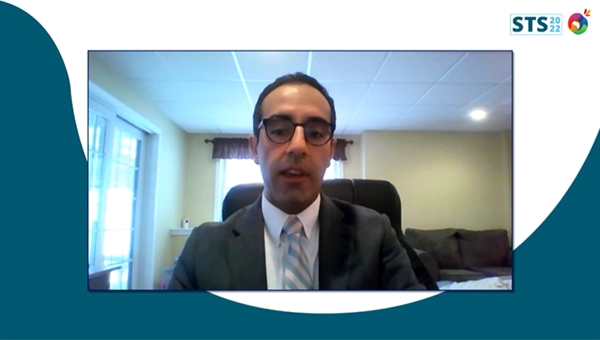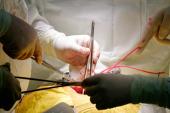Multiarterial CABG Still Underused Despite Better Outcomes
Future research needs to identify the barriers to using the multiarterial approach, which likely vary between hospitals.

The strategy of multiarterial grafting, which is endorsed by surgical guidelines, remains “underutilized” in current US CABG practice, although regional and institutional variability exists, according to researchers who conducted a new analysis of a Society of Thoracic Surgeons (STS) database.
Even though multiarterial CABG has been shown to reduce the long-term likelihood of death, MI, and repeat revascularization, several previous studies have shown that surgeons aren’t using it even in ideal patients.
“We've tried for a long time to implement and utilize the strategy, but it seems like it's still underutilized,” said Siavash Saadat, MD (University of Massachusetts-Baystate), who presented the findings Saturday during the virtual STS 2022 meeting. “We're seeing some improvements, of course, but we are still behind in terms of its utilization,” he told TCTMD.
The study, which did show an increase in multiarterial CABG from 10% to 14% between 2018 and 2019, highlights a substantial learning curve associated with the surgical technique, but this will only improve with experience, Saadat added.
Jennifer Lawton, MD (Johns Hopkins University, Baltimore, MD), who co-moderated the session, said the low rates of multiarterial grafting seen here are “disheartening.”
‘Universally Excellent’ Outcomes
For the study, Saadat along with Thomas Schwann, MD (University of Massachusetts-Baystate), and colleagues included 241,548 patients undergoing isolated CABG with at least one internal thoracic artery (ITA) and two or more grafts enrolled in the STS Adult Cardiac Surgery Database between 2018-2019. Patients were stratified into three cohorts based on the grafting strategy used: single arterial (SABG; 86%), bilateral ITA multiarterial (BITA-MABG; 5.6%), radial artery multiarterial (RA-MABG; 8.5%).
While the largest proportion of CABG patients were treated in the South over the study period, the region reported the lowest rates of multiarterial grafting, with 4% and 6% BITA and RA, respectively. At the institutional level, there was no correlation between overall CABG volume and multiarterial grafting use, with a national average of multiarterial grafting observed of 14%.
Generally, patients in the BITA group were younger and healthier with lower STS predicted risk scores, while those treated with SABG patients were older and had more comorbidities with higher STS scores, with RA patients falling somewhere in between. Total operative, cross clamp, and cardiopulmonary bypass times were higher in BITA and RA cohorts compared with SABG.
Mortality as well as major morbidity/mortality rates were lower for both BITA (1.2% and 8.6%) and RA-MABG (1.4% and 8.5%) compared with SABG (2.1% vs 11.1%). Deep sternal wound infection was more common in the BITA group, however, compared with RA-MABG and SABG (1.0% vs 0.6% vs 0.6%).
After risk adjustment, the observed to expected event (O/E) ratios based on 2017 data showed that outcomes for all groups were “universally excellent,” Saadat said, with no significant differences observed in mortality. However, the O/E ratio for major morbidity and mortality was highest in the BITA-MABG group compared with RA-MABG and SABG (1.13 vs 0.97 vs 1.00), and this was driven by deep sternal wound infection (1.91 vs 0.90 vs 0.96; P < 0.001 for all).
Looking at hospitals by case volume, outcomes for multiarterial grafting improved with experience. In particular, there was a systematic decrease in the O/E ratio for mortality from low- (< 10 in 2 years; 1.30) to intermediate- (10-30; 1.01) to high-volume institutions (> 30; 0.91) with a statistically significant difference between low- and high-volume centers (P = 0.048). The same trend was noted for major morbidity and mortality, but the risk of deep sternal wound infection remained persistently elevated for BITA-MABG regardless of institutional case volume. These patterns were even more pronounced for RA-MABG patients.
‘Multifactorial’ Learning Curve
Lawton commented on the “interesting” choice to consider 30 cases over 2 years to be high-volume. “[That] is very low volume in my opinion,” she said, adding that she “did four this week.”
Regarding the learning curve for multiarterial grafting, co-moderator Faisal Bakaeen, MD (The Cleveland Clinic Foundation, OH), pointed out that there is currently no minimum requirement for performing MABG specifically to graduate residency in the adult cardiac surgery track.
Lawton said that is unlikely to change, at least in the near future. “The board doesn’t tend to go down to that level of detail in terms of how to do a procedure. It's more in the number of procedures that you do,” she explained.
Saadat said while exposure during residency can help increase MABG use, the cause of the learning curve is multifactorial. “Our study was not granular enough to really hash out what the cause of that learning curve is—meaning it could be surgeon-specific, it could be institution-specific, [or perhaps] patient selection,” he said. “As with anything, the more you do, the better you should be at it. So, I think this is just really meant to home in on the fact that there is a learning curve and the next future studies should be looking at what the cause is, what impacts outcomes, of course, and what we can do to improve those outcomes and improve our utilization overall.”
Bakaeen agreed that future research should “look at specific surgeon volumes because at a lot of centers, you could find a surgeon who is the CABG surgeon—or two of them—that have excellent outcomes and then others that do it less frequently may not have such superb outcomes,” he said, adding that there might be an “inflection point” wherein overuse of either the BITA or RA may end up with worse outcomes. In those circumstances, “you’re doing it for show and not for the patient. So I think it's really important to look at patient selection and the surgeon you're dealing with.”
Overall, Saadat said he is “really proud” of the outcomes achieved so far with MABG. “It shows that . . . we could strive for those kinds of excellent outcomes,” he said. “I think it's going to be really important to continue on that trajectory to bring good outcomes for all of our patients.”
Yael L. Maxwell is Senior Medical Journalist for TCTMD and Section Editor of TCTMD's Fellows Forum. She served as the inaugural…
Read Full BioSources
Saadat S. Multi-arterial coronary artery bypass grafting practice patterns in the USA: a report from the STS database. Presented at: STS 2022. January 29, 2022.
Disclosures
- Saadat, Lawton, and Bakaeen report no relevant conflicts of interest.





Comments